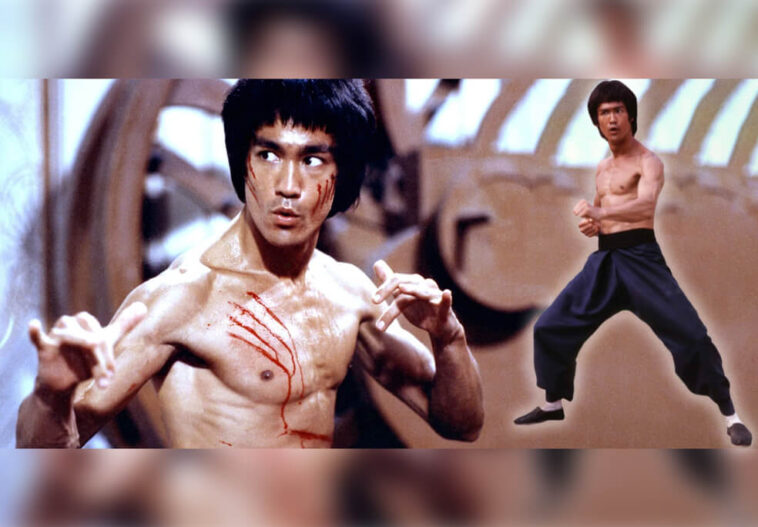The incredible career of Bruce Lee ended 50 years ago
Bruce Lee was more than just an actor and Martial arts specialist. He changed how the Chinese community is viewed in the East and the West, and is remembered as an everlasting cultural icon. Bruce Lee, whose life was brutally cut short, dramatically changed the way martial arts are perceived and understood. Even decades after his passing, his trailblazing adventure continues to inspire hordes of devotees.
Overview of Bruce Lee’s Background
Understanding Bruce Lee’s modest beginnings and quick rise to prominence is essential to understanding his significant influence. He was originally born in San Francisco in 1940, but once his family returned to Hong Kong, he spent his formative years there. Lee began intensive Wing Chun training as a youth after learning martial arts from his father. Eager to return to America, Lee moved back at age 18 to complete his university studies and pursue acting.
While trying to break into films, Lee taught martial arts and opened schools to support himself. This led to his breakout opportunity playing Kato in the TV series The Green Hornet, which first exposed Western audiences to dazzling kung fu skills. Hungry for greater stardom, Lee moved to Hong Kong and achieved global celebrity status through paradigm-shifting martial arts movies like Fists of Fury.
Even though Lee’s journey was tragically cut short, the martial arts explosion he helped ignite continued reverberating worldwide. His meteoric impact as both icon and innovator is an integral part of appreciating his immense legacy.
Bruce Lee’s Groundbreaking Martial Arts Legacy
It’s crucial to recognize Bruce Lee’s modest beginnings and quick ascent to popularity in order to fully comprehend his immense legacy. Although his family later moved to Hong Kong, where he spent his formative years as a youngster, he was born in San Francisco in 1940. Bruce’s father first exposed him to martial arts, igniting a love that lasted a lifetime.. As a teenager, Lee began intensive Wing Chun training that laid the foundation for his future success.
At 18, eager to return to America, Lee moved to pursue his university studies and acting dreams. To support himself, he taught martial arts and opened schools while trying to break into films. His big break came playing Kato in the hit TV series The Green Hornet, which first exposed Western audiences to dazzling kung fu. Hungry for greater stardom, Lee moved back to Hong Kong and became an international icon through groundbreaking martial arts blockbusters like Fists of Fury.
Though Lee’s meteoric career was devastatingly cut short, the martial arts wave he ignited continued rippling worldwide even after his death. Appreciating his humble origins and rapid rise to fame is key to fully grasping the enormity of his legacy.
Details on Bruce Lee’s Jeet Kune Do Philosophy
Jeet Kune Do, Bruce Lee’s most famous martial arts creation, condensed his ideas into a practical fighting style:
- Name, which means “Way of the Intercepting Fist”; emphasizes efficiency of movement and reaction
- Places a strong emphasis on combat usefulness, adaptability, flexibility, speed, and efficiency
- Removed ornamentation and restrictive shapes in favor of directness and fighting prowess
- Lee combined ideas from fencing, boxing, and other fighting techniques that he discovered to be effective.
- Made use of straightforward, non-classical postures and fighting-specific footwork.
- Emphasized the importance of nutrition, strength training, and physical fitness as the cornerstones of success
- Integrated Eastern philosophical ideas like self-actualization and mindfulness
- Acquired trapping expertise to block and restrain opponents’ limbs
Bruce Lee’s ground-breaking method of fusing mental, physical, and technical dynamics was personified in Jeet Kune Do. The teaching of martial arts was forever altered.
Influence on Martial Arts Movies
Without examining how Bruce Lee transformed martial arts film, a discussion of Bruce Lee is incomplete:
- Thanks to his charismatic on-screen personality, he propelled kung fu movies into the global mainstream.
- Featured Chinese lead characters as heroes, which was uncommon at the time in Western motion pictures.
- Introduced foreign audiences to Hong Kong action movies
- On-screen demonstrations of real martial arts, as opposed to exaggerated “fake” maneuvers
- Added philosophical and spiritual elements to intense fight scenes
- Exhibited unprecedented levels of lightning speed, power, and acrobatic skill.
- Integrated Chinese tradition with international filming methods and aesthetics
- Made fighting choreography into a choreographed artistic performance
Bruce Lee showed that martial arts might be more than just bare-knuckled combat. He became an immediate hero after this realization.
Notable Films That Cemented Bruce Lee’s Status
Several major movies represent milestone’s in Bruce Lee’s rise as a martial arts superstar:
The Big Boss (1971)
- Debut starring role established Lee as a formidable fighter and leading man
Fist of Fury (1972)
- First major Hong Kong hit fusing drama, nationalism, and hand-to-hand combat
Way of the Dragon (1972)
- Directed by and starring Lee, with the classic duel against Chuck Norris
Enter the Dragon (1973)
- Lee’s magnum opus and first US-produced martial arts spectacular
Game of Death (1978)
- Unfinished film completed after Lee’s death using stand-ins and archival footage
Though less than 5 films in total, this filmography cemented Bruce Lee as the archetypal martial warrior.
A Life Cut Short
Tragically, Bruce Lee’s life was cut far too short at the height of his fame. In July 1973, just weeks before the premiere of Enter the Dragon, Lee mysteriously passed away in Hong Kong at only 32 years of age. The official cause of death was ruled to be cerebral edema or swelling of the brain. However, speculation persists that factors like allergies, injury, or poisoning may have contributed to his sudden passing.
Lee’s son Brandon also died prematurely in 1993 due to an on-set firearms accident, compounding the tragedy. Bruce Lee was laid to rest in Seattle’s Lake View Cemetery, where devoted fans continue to visit his grave to this day to pay respects. The shocking loss of Lee at the peak of his stardom only magnified the legend surrounding his brief but monumental existence.
Remembering Brandon Lee
Similar to his legendary father, Brandon Lee carved himself his own niche in martial arts film:
- Bruce Lee and Linda’s only child, born in 1965
- Studied drama and martial arts while pursuing an acting career in adulthood.
- Had a breakthrough performance in Legacy of Rage (1986) as a nunchaku warrior.
- Played the heroic lead role of Eric Draven in the 1994 film The Crow.
- Was fatally injured by a pistol on site a few days before The Crow was finished being filmed.
- The Crow’s posthumous popularity solidified his cult reputation.
Before his fate paralleled that of his father, Brandon carved out his own identity as an action star while paying homage to Bruce Lee’s history.
Cultural Significance as a Chinese Icon
Bruce Lee continues to be a significant figure for the global Chinese identity outside of martial arts:
- Refuted prejudice and preconceptions by displaying the strength, masculinity, and heroism of Chinese people.
- When Asian males were consistently devalued in Western media, his self-assured on-screen demeanor was a revelation.
- By appearing in US movies and television shows, Asian actors have broken down barriers to representation.
- Awakened tremendous patriotic pride in China and among the diaspora
- Encouraged the adoption of Chinese culture by the general public through kung fu and Eastern ideologies
Lee provided the Chinese community with a strong, likable idol at a time when such prominence was lacking. He left behind a permanently altered cultural environment.
Bruce Lee’s Ongoing Pop Culture Influence
Years later, Bruce Lee continues to be omnipresent in popular culture, which is evidence of his enduring appeal:
- Remains one of the most well-known martial arts masters in the world.
- Long after his passing, his films and ideologies continue to draw new followers.
- He frequently has biopics, documentaries, and TV series about him.
- He is cited as a martial arts inspiration by celebrities such Jackie Chan and Conor McGregor.
- Lee’s likeness is commonly imprinted on clothing, posters, and other products.
- Lee is featured as a fictitious character in video games and animated TV shows.
- Followers make pilgrimages to statues and institutions that pay tribute to his legacy.
Bruce Lee’s fame is still growing even today. His compelling personality and significant impact do not constrain by time or place.
Preserving Bruce Lee’s Legacy
Although Bruce Lee’s life was brief, people still make efforts to share and preserve his legacy for future generations:
- His writings are recognized as founding principles of contemporary martial arts.
- The Bruce Lee Foundation Museum in Seattle has original training tools and memorabilia on exhibit.
- For 4K theatrical re-releases, Chinese studios are busily remastering and digitizing his classic movies.
- New documentaries are being created from newly discovered lost footage.
- Academics and fans gather at international conferences to discuss his influence
- His Jeet Kune Do fighting style and ideology are taught in instructional institutions
- Lee’s legendary nunchaku talents are honored through competitions for live performances.
Lee’s legacy is still important because his students are carrying on his lessons in a pioneering manner.
Conclusion – The Everlasting Impact of Bruce Lee
Although Bruce Lee’s extraordinary life was much too brief, his influence on the world has not faded. Bruce Lee profoundly changed the definition of martial arts with his spectacular on-screen persona, ground-breaking battle choreography, and profound philosophical ideas. His self-assured disdain of prejudices changed how the world saw Chinese identity. Bruce Lee set the bar high for others to follow by constantly pursuing their full potential without boundaries. Even if Lee’s absence from the martial arts scene today would make it unrecognizable, his ideas and passion continued to rise despite his passing.
Click here to find out more about Entertainment hot topics.





